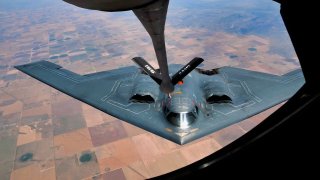Iran Could Decide to Build a Nuclear Weapon
The Biden administration's diplomatic stance towards Iran has seemingly strengthened Iran's position in the Middle East and its pursuit of nuclear capabilities. The significant advancements in Iran's nuclear program, coupled with decreased transparency and heightened security motivations, suggest a plausible scenario where Iran might decide to develop a nuclear weapon.
Summary: The Biden administration's diplomatic stance towards Iran has seemingly strengthened Iran's position in the Middle East and its pursuit of nuclear capabilities. The significant advancements in Iran's nuclear program, coupled with decreased transparency and heightened security motivations, suggest a plausible scenario where Iran might decide to develop a nuclear weapon.
Historical efforts to conceal nuclear activities under civilian guises, along with contributions from various international sources, have facilitated Iran's progress in nuclear technology. Despite sanctions and international scrutiny, Iran has made notable advancements, including enriching uranium to levels close to weapons-grade. The current global focus on other conflicts may provide Iran with an opportunity to further its nuclear ambitions. Iranian officials have openly discussed the country's capability to develop nuclear weapons if chosen, marking a shift in discourse towards a more assertive stance on nuclear capabilities. The potential for Iran to develop nuclear weapons raises significant concerns for global security and regional proliferation, emphasizing the need for a strategic approach to prevent Iran from achieving nuclear weapon status.
Inside Iran's Nuclear Ambitions: A Global Security Threat Unfolds
The Biden administration’s conciliatory approach towards the Islamic regime in Iran has significantly bolstered its position in the Middle East and emboldened its pursuit of nuclear weapons capabilities. If the United States government continues to ignore Iran’s nuclear developments, it may decide to build an atomic bomb. The prospect of such a scenario is plausible given the significant growth in the regime’s nuclear capabilities, a sharp decline in the program’s transparency, and increased security incentives for the government to build the bomb amidst shifting global priorities.
Ever since the Islamic Republic restarted the Shah’s nuclear program, the regime has intended to produce nuclear weapons. Taking advantage of the weak Non-Proliferation Treaty (NPT), the Ayatollah's regime launched an illicit nuclear project under the façade of a civilian program. This “hiding in plain sight” plan benefited from several factors, including the willingness of countries from the Nuclear Suppliers Group (NSG), like Russia and China, to sell materials and technology, the input of rogue regimes, such as North Korea, and the efforts of rogue agents, like Pakistani nuclear scientist A. Q. Khan, and the regime’s capability to establish a vast network of front companies for buying dual-use technology. In addition, IAEA’s lax oversight and readiness under Mohammed El-Baradei to declare the program peaceful also contributed. The sheer complexity of the political system in Tehran and the regime's finely honed deception tactics confirmed its leader's beliefs that the cost of achieving a weapon system was tolerable.
However, in 2002, the National Council of Resistance of Iran (NCRI) disclosed that Iran was covertly producing nuclear materials in two secret facilities in Natanz and Arak. The facilities were going to house centrifuges capable of producing significant quantities of uranium and plutonium enriched to a weapon-grade level. As a result, the international community imposed crippling sanctions on the regime, forcing it to engage in a serious cost-benefit analysis. As a result, the regime decided that the program’s cost exceeded its benefits. On July 14, 2015, the regime agreed to restrictions on its nuclear program through the Joint Comprehensive Plan of Action (JCPOA).
However, in May 2018, President Trump withdrew the United States from the pact and re-imposed sanctions on Iran. Since then, the regime has made dangerous technical progress in its nuclear program. The IAEA estimated that as of October 28, 2023, Iran’s uranium stockpile contained 4,130.7 kg of uranium in the form of hexafluoride (UF6). 2,218.1 kg was enriched up to 5 percent, 567.1 kg was enriched up to 20 percent, and 128.3 kg was enriched up to 60 percent. According to the estimates, it would take the regime one week to enrich enough uranium for three weapons, two weeks for four, and three weeks for five if it decides to build them.
The transparency of the nuclear program has decreased significantly due to Iran’s intransigence with the International Atomic Energy Agency (IAEA). In June 2022, Iran removed all IAEA surveillance and monitoring equipment. It expelled the agency inspectors from the country, which directly and seriously affected the IAEA’s ability to effectively conduct its inspections and verification activities in Iran’s enrichment facilities. Despite the IAEA Director General Rafael Grossi urging Iran to reconsider, the regime has not altered its direction. Additionally, “significant safeguards issues remain outstanding” in Iran’s nuclear program. According to Grossi, the primary issue remains traces of uranium, which the inspectors found at three previously undeclared sites.
A comprehensive review of all relevant information by the IAEA is crucial to confirm there is no misuse of declared nuclear materials for non-peaceful purposes, secret production or processing at known sites or elsewhere, and no undeclared nuclear materials or activities in a state under a comprehensive safeguards agreement.
In addition to the dangerous technical progress that the regime has made in its nuclear program, other factors could facilitate Iran’s ability to build a bomb, especially when global attention is focused elsewhere.
The war in Ukraine and the conflict between Israel and Hamas have significantly diverted the United States, European Union, and Israel’s focus and resources, shifting attention away from Iran. Internationally, around thirty Western countries have mobilized their resources to repel Russian aggression against Ukraine, with European leaders concerned the conflict might extend to Western Europe, further diverting attention from Iran. The Islamic Republic might benefit from these distractions and advance its nuclear program while global attention is elsewhere.
The conflict between Hamas and Israel, along with Hezbollah’s rocket attacks on Israel since October 7, has shifted the state’s attention away from Iran’s nuclear ambitions. Additionally, Iran’s proxy wars against the U.S. forces in Iraq, Syria, Jordan, and Yemen and the U.S. retaliation against these proxies have preoccupied much of Washington’s attention.
Counterintuitively, the overwhelming retaliatory strikes by the United States and Israel against Iranian proxies may have heightened the regime’s motivation to pursue nuclear weapons. The regime might conclude that possessing nuclear arms is the only way to deter these nations from opposing Iran’s regional ambitions and its quest for dominance in the Middle East.
Given the significant growth in the regime’s nuclear capabilities, a sharp decline in the program’s transparency, increased security incentives for Iran to develop nuclear weapons, and the global focus being elsewhere, Iran might seize the opportunity to build the bomb.
Adding to this is the shift in the discourse in Tehran. Iranian officials, who in the past were silent on the matter, have recently been quite upfront about their readiness to develop a nuclear weapon if they choose to do so. For instance, Ali Akbar Salehi, the former head of Iran's Atomic Organization, recently said that Iran possesses all the necessary components to construct a nuclear bomb. Salehi compared the process to building a car, stating, “We have all the pieces of nuclear science and technology. Let me give an example: what does a car need? It needs a chassis, an engine, a steering wheel, and a gearbox. Have you made a gearbox? I say yes. An engine? …We have it in our hands.” As David Albright, a world-leading weapons expert and the founder of the Institute for Science and International Security, pointed out, in terms of Iran’s nuclear threat, “we’re at a point of Extreme Danger. It’s the first time in years we see all the stars come together into a constellation where Iran may decide to build nuclear weapons.”
Iran’s breakout would have catastrophic implications for global security and non-proliferation in the region. Once Iran is perceived to be developing an arsenal, regional powers will try to acquire nuclear weapons of their own. The U.S. government should implement strategies to prevent Iran from exploiting the situation to develop nuclear weapons.
Washington and its allies should pressure the regime to permit IAEA inspectors to enforce monitoring and safeguard agreements. This would enable inspectors to verify that the stockpile of enriched uranium is not misappropriated or transferred from current sites for use in weaponization.
President Biden should put Iran on notice, making it clear to the regime leaders that failure to maintain cooperation with the IAEA might lead the United States to consider military action. Iran must perceive this warning as credible rather than just diplomatic talk. Failure to arrest Iran’s nuclear development may encourage the regime to build the bomb.
Farhad Rezaei is a senior fellow at the Philos Project.
Image: Shutterstock.com.


